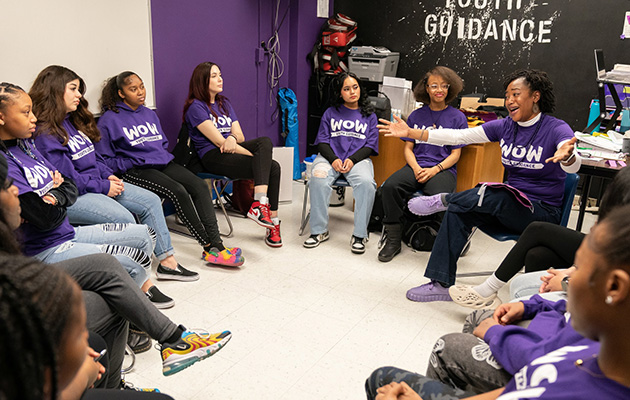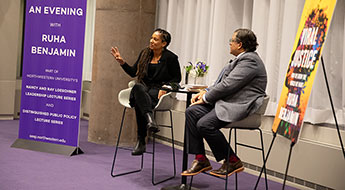New IPR Research: December 2023
Get all our news

This month's new research from IPR faculty examines the relationship between suicidal thoughts and social disconnection in older adults, the impacts of LSD on brain function, whether a top-four primary enhances moderate candidates’ chances of winning both the primary and general elections, and how the use of specific moral words connects or differentiates political candidates in recent U.S. elections. It also examines the effectiveness and affordability of a school-based counseling program and how preconceived biases influence the way that individuals interpret data.
Social Disparities and Health
Social Disconnection and Thoughts of Suicide Among Older Adults
How prevalent are thoughts of suicide and social disconnection among older adults, and how are they connected? In Journal of Affective Disorders, IPR political scientist James Druckman, IPR graduate research assistant Jennifer Lin, and their colleagues examine the relationship between suicidal thoughts and social disconnection, characterized by social isolation and lack of emotional social support, among older adults in the United States. The researchers surveyed 16,164 adults aged 65 and older in all 50 states in six waves between February and December 2021. The participants were asked about their emotional, financial, and health supports, feelings of loneliness, and whether they experienced thoughts of suicide. A total of 1,144 people, or 7.1% of respondents, reported thoughts of suicide in the past two weeks, including 386 who reported it more than half the time. Living alone was not associated with higher suicide rates among older adults. Rather, rates of suicidal thoughts and behavior were lower among those who lived alone or with a partner than among those living in larger households. Thoughts of suicide were more likely to occur among those who had fewer social supports, especially emotional ones, and higher levels of loneliness. The results demonstrate that social disconnection and thoughts of suicide are common among older adults, and lack of emotional support is the strongest predictor of suicidal thoughts in older adults. This study highlights the need for future research to further examine the relationship between social disconnection and suicidal thoughts. The researchers also suggest that targeted psychosocial interventions, such as streamlined psychotherapy, may help address social risk factors in this vulnerable population. Druckman is Payson S. Wild Professor of Political Science.
The Impacts of LSD on Brain Function
How do low doses of LSD impact reward processing in the brain? Existing knowledge has found that psychedelics may be beneficial in treating depression by affecting emotions about events and their outcomes. Since previous studies use high doses, IPR psychologist Robin Nusslock and colleagues explore what effects low doses of LSD have on brain processes in Neuropsychopharmacology. The treatments were a low dose of LSD (26 micrograms, or LSD-26), an even lower dose (13 micrograms, or LSD-13), and a placebo as a control. Eighteen healthy young adults went through three five-hour sessions, receiving one of the two LSD doses or a placebo each session. Two to three hours after taking the drug, an EEG was performed to measure reactions to positive and negative feedback that participants received while being tested on how quickly they tapped a button on a screen. Results indicated that the LSD-13 doses had the biggest effect on ongoing positive reactions and that LSD-13 and LSD-26 had greater positive effects on mood than the placebo. The findings suggest microdoses of LSD increase neural reactions to positive feedback, increasing motivation through reinforcing actions. If these findings can be extended to repeated doses, microdosing could be used to alleviate symptoms of depression in some patients.
Politics, Institutions & Public Policy
Top-Four Primaries Help Moderate Candidates Via Crossover Voting

Highly partisan voters tend to dominate U.S. primary elections, making it difficult for moderate candidates to intellections and leading to efforts to reform the electoral process. The electoral challenges that moderates face are important because moderate candidates might represent a broader swath of the electorate than the ideological partisans often favored in primaries. In The Forum, IPR political scientist Laurel Harbridge-Yong and her colleagues study reforms put in place for the 2022 Alaska election to assess whether a top-four primary, where all candidates are listed on the ballot and voters can pick regardless of the candidate's party affiliation, enhances moderate candidates’ chances of winning both the primary and general elections. The researchers asked six experts to identity the most moderate candidates in Alaska’s 2022 primary elections for statewide and state legislative races. They compared how successful these moderate candidates were under Alaska’s top-four primary to a hypothetical partisan primary with the same set of candidates and voters. They did this to understand whether moderates who would have lost in the old primary system go on to win the general election under the new election system. They also examine whether top-four primaries bring out more moderate voters to the polls compared to the old partisan primary system and whether the ability to vote for different parties increased crossover voting. They find that the top-four primary in 2022 likely benefited moderate candidates, especially in the scenarios where only candidates from one party ran in the primary. They calculate that at least two moderate candidates, who would have lost in the old system, emerged from the top-four primary and won the general election under the new system. More undecided voters participated in 2022 compared to the previous partisan primary in 2020, which suggests that the reform opens opportunities for more participation. And opportunities for crossover voting allowed voters from the other party to support the moderate candidate, such as in the race for U.S. senator where crossover Democratic voters helped Republican Lisa Murkowski perform better than Democratic candidates and her co-partisan rival. The results provide suggestive evidence that top-four elections can increase moderate candidates’ chances of winning.
Networks of Polarization and Unity in U.S. Presidential Primary Campaigns
Moral rhetoric—or emphasizing ideas of what is right and wrong—is a powerful persuasion technique for candidates running for election. In PNAS Nexus, Kellogg social psychologist and IPR associate William Brady and his colleagues analyze how the use of specific moral words connects or differentiates political candidates in recent U.S. elections. The researchers examined a dataset of 139,412 tweets published by 39 U.S. presidential candidates during the 2016 and 2020 primary elections. They pulled moral language from the tweets, placing the language into five categories: care, fairness, loyalty, authority, and sanctity. The researchers then created network models to reveal patterns and points of distinction in the candidates’ rhetoric. They find that candidates “push away” from the other party with Democratic candidates using more care and fairness language, while Republican candidates used more loyalty, authority, and sanctity language. They also discover that candidates from each party used moral language in highly similar ways, demonstrating how outsider candidates like Donald Trump can separate themselves from others by avoiding the party’s common moral language. The findings show how candidates can use moral language to isolate themselves from their peers, like Trump did in 2016, or to insulate themselves among them, like Joe Biden did in 2020. The researchers suggest that the way candidates express moral rhetoric online may contribute to polarization in social networks. They highlight several future directions for research, including mapping language across election cycles and in different types of elections.
Child, Adolescent & Family Studies
In-School Counseling Program Improves Teen Girls’ PTSD Symptoms

Young women, especially Black and Latina girls, suffer disproportionately from trauma-related depression, PTSD, and anxiety, yet little is known about effective treatment options. In Science Advances, IPR economist Jonathan Guryan and his colleagues examine the effectiveness and affordability of a school-based counseling program, Working on Womanhood (WOW), a trauma-informed, relationship-centered counseling and mentoring program designed by and for Black and Latina women. WOW focuses on addressing anxiety, depression, and PTSD in young women of color and was developed and delivered by Youth Guidance, a social services provider based in Chicago. The study is the first large-scale randomized controlled trial of such an initiative for young women in Chicago. Across the 2017–18 and 2018–19 school years, 3,749 high school girls in 10 public schools in Chicago participated in the study. The research finds that attending the weekly in-school counseling program for four months decreased participants’ PTSD symptoms by 22%, depression by 14%, and anxiety by nearly 10%. The results suggest that group-based, in-school therapy programs such as WOW can improve mental health symptoms. The results also highlight the lack of alternative mental health services available to young women. The authors conclude that WOW appears very cost-effective when judged based on its ability to alleviate mental health symptoms. Guryan is Lawyer Taylor Professor of Education and Social Policy.
Performance Measurement & Rewards
Impact of Bias on Data Interpretation
How do preconceived biases influence the way that individuals interpret data? In IEEE Transactions on Visualization and Computer Graphics, psychologist and IPR associate Steven Franconeri and his team investigate this question by conducting two studies. In the first study, 295 adult participants viewed four different scatterplots, two with moderate correlations of 0.4, and two that were highly related with correlations of 0.6. The scatterplots were either labeled with named, related variables, such as number of environmental regulations and air quality, or with “X” and “Y.” After viewing them, participants reported how much they believed the variables for each scatterplot to be related. The second study was conducted similarly, except 300 participants reported how much they believed the named variables from the first study were related before they saw the scatterplots labeled with “X” and “Y.” The results of both studies demonstrate that participants who thought the variables were related overestimated the correlation values, while participants who thought that they were not underestimated the correlation values. The research shows that the participants’ preconceived biases influenced their viewing of the data. These findings are significant for researchers whose data interpretations may be influenced by their hypotheses or preconceived beliefs, as well as for data communicators because no matter how definitive the data are, their audience may misinterpret them.
Photo credits: Pexels, iStock, and UChicago’s Education Lab.
Published: December 11, 2023.


